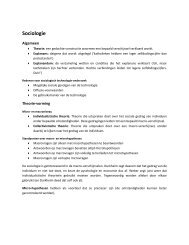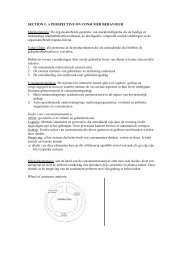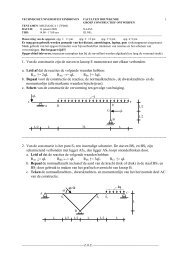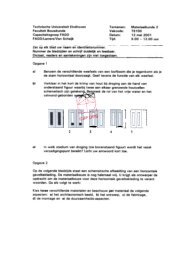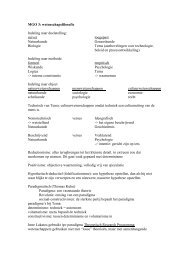Voorbeeldtentamen Engineering Economy (1A350) Tijdsduur 3 uur
Voorbeeldtentamen Engineering Economy (1A350) Tijdsduur 3 uur
Voorbeeldtentamen Engineering Economy (1A350) Tijdsduur 3 uur
You also want an ePaper? Increase the reach of your titles
YUMPU automatically turns print PDFs into web optimized ePapers that Google loves.
<strong>Voorbeeldtentamen</strong><br />
<strong>Engineering</strong> <strong>Economy</strong><br />
(<strong>1A350</strong>)<br />
<strong>Tijdsd<strong>uur</strong></strong> 3 <strong>uur</strong><br />
1
Problem 1 (financieel management)<br />
Measur Enterprise produces standardized telephone keypads and operates in a<br />
highly competitive market in which the keypads are sold for $ 4 each. Because of<br />
the nature of the production technology, the firm can produce only between<br />
10,000 and 13,000 units per month, in fixed increments of 1,000 units. Measur<br />
has the following cost structure (in $):<br />
# units 10,000 11,000 12,000 13,000<br />
Variable factory cost 37,000 41,600 44,600 48,400<br />
Fixed factory cost 9,000 9,000 9,000 9,000<br />
Variable selling cost 6,000 6,900 7,400 8,200<br />
Fixed administration cost 6,000 6,000 6,000 6,000<br />
Total cost 58,000 63,500 67,000 71,600<br />
Average unit cost 5.80 5.72 5.58 5.51<br />
At which output level should the firm operate?<br />
a. 10,000 units<br />
b. 11,000 units<br />
c. 12,000 units<br />
d. 13,000 units<br />
# units 10,000 11,000 12,000 13,000<br />
Revenue 40,000 44,000 48,000 52,000<br />
Cost 58,000 63,500 67,000 71,600<br />
Losses 18,000 18,500 19,000 19,600<br />
2
Problem 2 (financieel management)<br />
CLIC manufactures two types of cigarette lighters: Basic and Super. A new plant<br />
began producing both lighter models this year. The following variable costing<br />
statement summarizes the first year of operations:<br />
Product Basic Super Total<br />
# units produced 200,000 160,000<br />
# units sold 180,000 110,000<br />
Selling price $0.50 $0.70<br />
Sales Revenue $90,000 $77,000 $167,000<br />
Cost of goods sold $18,000 $22,000 $40,000<br />
Manufacturing margin $72,000 $55,000 $127,000<br />
Fixed Overhead $103,000<br />
Income from manufacturing $24,000<br />
For internal control purposes, variable costing is used. Management also wants<br />
income from manufacturing calculated using absorption costing. Fixed overhead<br />
is allocated to the two lighters using actual machine minutes. Each Basic lighter<br />
requires 1.1 machine minutes and each Super lighter requires 1.2 machine<br />
minutes.<br />
Calculate the plants income from manufacturing for the Basic lighter using<br />
absorption costing.<br />
a. $ 10,200<br />
b. $ 17,000<br />
c. $ 22,000<br />
d. $ 22,500<br />
200,000 * 1.1 + 160,000 * 1.2 = 412,000 minutes<br />
103,000/412,000 = 0.25 per minute<br />
Super: 180,000 * 1.1 * 0.25 = 49,500<br />
Profit is $ 72,000 – 49,500 = $ 22,500<br />
3
Problem 3 (appendix A1)<br />
Brickley Chains produces five different styles of silver chains: A, B,C, D and E.<br />
The following table summarizes the production and cost data for the five<br />
products.<br />
Product Annual Volume Direct Labour per Direct Material per unit<br />
Unit<br />
A 5,000 $2 $4<br />
B 3,000 $2. 50 $4.50<br />
C 1,000 $3 $5<br />
D 800 $4 $6<br />
E 500 $5 $7<br />
Annual overhead is $ 80,000. This overhead consists entirely of the automated<br />
machining process. Each chain is produced in batches with chains of the same<br />
type. Each batch requires the same amount of machine time. That is, producing<br />
a batch of 100 style A chains requires the same amount of machine time as a<br />
batch of 25 style E chains. The following table summarizes the batch size for<br />
each type of chain:<br />
Product Batch size<br />
A 100<br />
B 100<br />
C 50<br />
D 40<br />
E 25<br />
Compute the unit cost of D using Activity Based Costing<br />
a. $ 12.70<br />
b. $ 22.21<br />
c. $ 22.70<br />
d. $ 24.29<br />
# batches voor D is 800/40 = 20. Total # batches is 140. Total cost 80,000.<br />
Price per batch is 80,000/140 = 571.428. For D.. 20 * 571.428 = 11,429.<br />
Unit D cost: 4 + 6 + 11,429/800 = 24.29<br />
4
Problem 4 (3.38, moderated)<br />
A loan of $ 4,000 is to be repaid over a period of eight years. During the first four<br />
years, exactly $ 1,000 of the loan principal is to be repaid (along with<br />
accumulated compound interest) by a uniform series of payments of A1 dollars<br />
per year. The other $ 3,000 of the loan principal is to be repaid over four years<br />
with accumulated interest by a uniform series of payments of A2 dollars per year.<br />
If i = 9% per year, what are A1 and A2?<br />
a. A1 = $ 656 and A2 = $ 542<br />
b. A1 = $ 1,016 and A2 = $ 926<br />
c. A1 = $ 656 and A2 = $ 926<br />
d. A1 = $ 1,016 and A2 = $ 542<br />
A1 = [ 4000 (F/P, 9%, 4) – 1000] [A/F, 9%,4] = 1016<br />
A2 = 3000 (A/P, 9%,4) = 926<br />
5
Problem 5 (2.27)<br />
An automatic machine can be operated at three speeds, with the following<br />
results:<br />
Speed Output<br />
Time between Tool Grinds<br />
(pieces per hour) (hours)<br />
A 400 15<br />
B 480 12<br />
C 540 10<br />
A set of unsharpened tools costs $ 150 and can be ground 20 times. The cost of<br />
each grinding is $ 25. The time required to change and reset the tool is 1.5 hour,<br />
and a tool–setter who is paid $ 8 dollar per hour, makes such changes. Variable<br />
overhead on the machine is charged at the rate of $ 3.75 per hour, including toolchanging<br />
time.<br />
At which speed should the machine be operated to minimize total cost per<br />
piece?<br />
a. A<br />
b. B<br />
c. C<br />
Relevant costs:<br />
Cycletime Costs per piece<br />
c 11.5 11.5 * 3.75/10 *540 = 0.00798<br />
b 13.5 13.5 * 3.75/12 *480 = 0.00879<br />
a 16.5 16.5 * 3,75/15 *400 = 0.0103<br />
6
Problem 6 (4.47)<br />
The prospective exploration for oil in the outer continental shelf by a small<br />
independent drilling company has produced a rather curious pattern of cash<br />
flows, as follows:<br />
End of Year Net Cash Flow<br />
0 - $ 520,000<br />
1-10 + $ 200,000<br />
10 - $ 1,500,000<br />
The $ 1,500,000 expenses at the end of the year 10 will be incurred by the<br />
company in dismantling the drilling rig.<br />
The company expects to earn at least 20% per year on invested capital before<br />
taxes. Use the ERR method (ε = 20%).<br />
Is the project economically acceptable?<br />
a. No, because ERR is 0.5 %<br />
b. Yes, because ERR is 21.15%<br />
c. Yes, because ERR is 21.65%<br />
d. Yes, because ERR is 28.8 %<br />
[-520,000 – 1,500,000(P/F, 20%,10)] [F/P, i%, 10] = 200,000 (F/A, 20%,10)<br />
762,250 (1+i) ↑ 10 = 5,191,740<br />
i = 21.15%<br />
or: (not the best answer, but ...)<br />
[-520,000] [F/P, i%, 10] = 200,000 (F/A, 20%,10) – 1,500,000<br />
520,000 (1+i) ↑ 10 = 3,691,740<br />
i = 21.65%<br />
7
Problem 7 (5.19)<br />
As the supervisor of a facilities engineering department, you consider mobile<br />
cranes to be critical equipment. The purchase of a new medium-sized, truckmounted<br />
crane is being evaluated. The economic estimates for the two<br />
alternatives are shown in the table:<br />
Alternatives A B<br />
Investment $ 272,000 $346,000<br />
Annual expenses $28,800 $19,300<br />
Useful life (Years) 6 9<br />
Market Value (at end of life) $25,000 $ 40,000<br />
You have selected the longest useful life for the study period and would lease a<br />
crane for the final three years under alternative A. At that time the leasing cost<br />
will be $ 66,000 per year (plus the annual expenses of $28,800 per year). The<br />
MARR is 15%.<br />
Which alternative you prefer?<br />
a. A, because PW (A) < PW (B)<br />
b. A, because PW (A) > PW (B)<br />
c. A, because A requires the least capital investment<br />
d. B, because the ERR of the differences in cash flow between A and B<br />
is greater than MARR.<br />
Year Differences between A-B<br />
0 - 74,000<br />
1-5 9,500<br />
6 -15,500<br />
7-8 75,500<br />
9 115,500<br />
[-74,000 – 15,500(P/F,15%,6)] [F/P, i, 9]=9,500(F/A,15%,5)(F/P, 15%,4) +<br />
75,500(F/A,15%,3) + 40,000<br />
80,701 (1 + i) ↑ 9 = 404,202 i = 19.9 % > MARR<br />
8
Problem 8 (9.13, moderated)<br />
Consider a piece of equipment that initially cost $8,000 and has these estimated<br />
annual expenses and market values:<br />
End of Year, k Annual Expenses MV at End of Year<br />
1 -$3,000 $4,700<br />
2 - 3,000 3,200<br />
3 - 3,500 2,200<br />
4 - 4,000 1,450<br />
5 - 4,500 950<br />
6 - 5,250 600<br />
7 - 6,250 300<br />
8 - 7,750 0<br />
If the before-tax MARR is 10 % per year, determine the economical life of<br />
this equipment.<br />
a. 3 year<br />
b. 4 year<br />
c. 5 year<br />
d. 6 year<br />
Year Costs (incl intrest) EUAC<br />
1 7100 7100<br />
2 4970 4141<br />
3 4820 3621<br />
4 4970 3395<br />
5 5145 3195<br />
6 5695 3215<br />
9
Problem 9 (7.29, moderated)<br />
If 846.2 labour hours are required for the third production unit, and 783 labour<br />
hours are required for the fifth production unit, determine the learning curve<br />
parameter s.<br />
a. 0.95<br />
b. 0.9<br />
c. 0.85<br />
d. 0.8<br />
846.2 = (3/5) ↑ n<br />
783<br />
1.0807 = (6/10) ↑ n<br />
log 1.0807 = n log (0.6)<br />
n = - 0.1520<br />
n = log s = - 0.1520<br />
log 2<br />
log s = -0.04576<br />
s = 0.9<br />
10
Problem 10 (10.10)<br />
A nationwide motel chain is considering locating a new motel in big town, USA.<br />
The cost of the 150-room motel (excl. furnishings) is $ 5 million. The firm uses a<br />
15-year planning horizon to evaluate investments of this type. The furnishings for<br />
this motel must be replaced every five years at an estimated cost of $ 1,875,000<br />
(at moment k = 0, k = 5 and k = 10). The old furnishings have no market value.<br />
Annual operating and maintenance expenses are estimated to be $ 125,000. The<br />
market value of the motel after 15 years is estimated to be 20% of the original<br />
building cost.<br />
Rooms at the motel are projected to be rented at an average rate of $ 45 per<br />
night. On the average, the motel will rent 60% of its rooms each night. The motel<br />
will be open 365 days per year. The MARR is 10% per year.<br />
The project is economically feasible, because the AW is $ 232,625.<br />
Investigate sensitivity to decision reversal for the following three factors:<br />
a. Occupancy Rate (average percent of rooms rented per night)<br />
b. MARR<br />
c. Capital investment<br />
To which of these factors is the decision most sensitive?<br />
Capital Investment: 232,625 – 5,000,000 (A/P,10%,15) X = 0<br />
X = 0.3538 or 35.38%<br />
Marr: IRR = 14.3% (by trial and error), therefore, the Marr must increase by<br />
14.3/10 –1 = 43%<br />
Occupancy Rate: 232,625 + (45(150)(365)(0,6) X = 0<br />
X = - 0.15.74 or 15.74%<br />
The decision is most sensitive to changes in occupancy rate (requires the<br />
smallest percent change to reverse te decision)<br />
11
Problem 11 (11.5)<br />
A non profit government corporation is considering two alternatives for generating power:<br />
A:<br />
Build a coal-powered generating facility at a cost of $20,000,000. Annual power sales are<br />
expected to be $ 1,000,000 per year. Annual operating and maintenance costs are $ 200,000 per<br />
year. A benefit of this alternative is that it is expected to attract new industry, worth $ 500,000 per<br />
year, to the region.<br />
B:<br />
Build a hydroelectric generating facility. The capital investment, power sales and operating costs<br />
are $ 30,000,000; $ 700,000; and $ 100,000 per year, respectively. Annual benefits of this<br />
alternative are as follows:<br />
• Flood-control savings $ 600,000<br />
• Irrigation $ 200,000<br />
• Recreation $ 100,000<br />
• Ability to attract new<br />
Industry $ 400,000<br />
The useful life of both alternatives is 50 years.<br />
Using an interest rate of 5% determine which alternative should be selected according to<br />
the conventional B-C ratio method.<br />
a. A, because B/C-ratio of A > B/C-ratio of B<br />
b. A, because B/C-ratio of A > 1<br />
c. B, because B/C-ratio of B > B/C-ratio of A<br />
d. B, the incremental analysis of (A,B) shows ∆ B/ ∆C is greater than 1<br />
Incremental analysis B-A:<br />
Investment; 10,000,000<br />
O&M: 1,000,000<br />
Power Sales: - 200,000<br />
Other: 800,000<br />
∆ B/ ∆C = 800,000 – 200,000 = 600,000 = 1.34 > 1, select B<br />
10,000,000 (A/P,5%, 50) – 100,000 448,000<br />
12
Problem 12 (9.7a, moderated)<br />
The replacement of a planning machine is being considered by the Reardorn<br />
Furniture Company. (There is an indefinite future need for this type of machine).<br />
The best challenger will cost $ 30,000 installed, and will have an estimated<br />
economic life of 12 years and a $ 2,000 MV at that time. It is estimated that<br />
annual expenses will average $ 17,000 per year. The defender has a present BV<br />
of $ 6,000 and a present MV of $ 4,000. Data for the defender for the next<br />
three years are as follows (in dollars):<br />
Year MV at end year BV at end of year Expenses during the year<br />
1 3,000 4,500 20,000<br />
2 2,500 3,000 25,000<br />
3 2,000 1,500 30,000<br />
Using a rate of 15% per year, make a comparison to determine whether it is<br />
economical to make the replacement now.<br />
a. No, because the economic life of the defender is 1 year<br />
b. No, the EUAC of the defender is less than the EUAC of the<br />
challenger<br />
c. Yes, the EUAC of the challenger is less than $21,600.<br />
d. Yes, the EUAC of the defender is $ 21,600 and is less than the<br />
EUAC of the challenger<br />
Defender:<br />
Year CR amount Expenses Total EUAC<br />
1 4000(0.15) + (4000-3000)= 1600 20000 21600 21600<br />
2 3000(0.15) + (3000-2500)= 950 25000 25950 23622<br />
3 2500(0.15) + (2500-2000) = 875 30000 30875 25713<br />
Challenger:<br />
EUAC= 30,000 (A/P,15%,12) – 2,000 (A/F, 15%,12) + 17,000 = 22,466<br />
The EUAC of the defender is less than the EUAC of the challenger.<br />
13
Problem 13 (9.6)<br />
A present asset (defender) has a current market value of $87,000 (MV0). Based<br />
on the used equipment market, the estimated market values at the end of the<br />
next three years are MV1 = $76,000, MV2 = $60,000, MV3 = $40,000. The<br />
annual expenses are $18,000 in the present year, and are growing 4,1% each<br />
year. The MARR is 10% per year. The best challenger available has an<br />
economic life of six years, and its EUAC over this period is $44,210.<br />
Based on this information and before-tax analysis, when should you plan<br />
to replace the defender with the challenger?<br />
Defender:<br />
a. Immediately<br />
b. After 1 year<br />
c. After 2 year<br />
d. After 3 year<br />
EOY Market Loss in Cost of Annual Total EUAC<br />
Value Value Capital Expenses Cost<br />
0 87,000 - - - - -<br />
1 76,000 11,000 8,700 18,738 38,438 38,438<br />
2 60,000 16,000 7,600 19,506 43,106 40,661<br />
3 40,000 20,000 6,000 20,306 46,306 42,364<br />
Annual expenses for year k = $18,000 (1.041) K<br />
The defender should be replaced after two years. Although the EUAC for<br />
the defender through year three is less than the EUAC of the challenger,<br />
the marginal cost of keeping the defender for the third year is greater than<br />
the EUAC of the challenger ($46,306>$44,210)<br />
14




